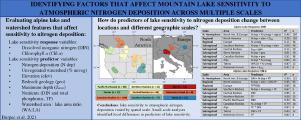Water Research ( IF 12.8 ) Pub Date : 2021-11-19 , DOI: 10.1016/j.watres.2021.117883 Benjamin T Burpee 1 , Jasmine E Saros 1 , Leora Nanus 2 , Jill Baron 3 , Janice Brahney 4 , Kyle R Christianson 5 , Taylor Ganz 6 , Andi Heard 7 , Beth Hundey 8 , Karin A Koinig 9 , Jiří Kopáček 10 , Katrina Moser 11 , Koren Nydick 12 , Isabella Oleksy 13 , Steven Sadro 14 , Ruben Sommaruga 9 , Rolf Vinebrooke 15 , Jason Williams 16

|
Increased nitrogen (N) deposition rates over the past century have affected both North American and European mountain lake ecosystems. Ecological sensitivity of mountain lakes to N deposition varies, however, because chemical and biological responses are modulated by local watershed and lake properties. We evaluated predictors of mountain lake sensitivity to atmospheric N deposition across North American and European mountain ranges and included as response variables dissolved inorganic N (DIN = N NH4+ + N
NH4+ + N NO3–) concentrations and phytoplankton biomass. Predictors of these responses were evaluated at three different spatial scales (hemispheric, regional, subregional) using regression tree, random forest, and generalized additive model (GAM) analysis. Analyses agreed that Northern Hemisphere mountain lake DIN was related to N deposition rates and smaller scale spatial variability (e.g., regional variability between North American and European lakes, and subregional variability between mountain ranges). Analyses suggested that DIN, N deposition, and subregional variability were important for Northern Hemisphere mountain lake phytoplankton biomass. Together, these findings highlight the need for finer-scale, subregional analyses (by mountain range) of lake sensitivity to N deposition. Subregional analyses revealed differences in predictor variables of lake sensitivity. In addition to N deposition rates, lake and watershed features such as land cover, bedrock geology, maximum lake depth (Zmax), and elevation were common modulators of lake DIN. Subregional phytoplankton biomass was consistently positively related with total phosphorus (TP) in Europe, while North American locations showed variable relationships with N or P. This study reveals scale-dependent watershed and lake characteristics modulate mountain lake ecological responses to atmospheric N deposition and provides important context to inform empirically based management strategies.
NO3–) concentrations and phytoplankton biomass. Predictors of these responses were evaluated at three different spatial scales (hemispheric, regional, subregional) using regression tree, random forest, and generalized additive model (GAM) analysis. Analyses agreed that Northern Hemisphere mountain lake DIN was related to N deposition rates and smaller scale spatial variability (e.g., regional variability between North American and European lakes, and subregional variability between mountain ranges). Analyses suggested that DIN, N deposition, and subregional variability were important for Northern Hemisphere mountain lake phytoplankton biomass. Together, these findings highlight the need for finer-scale, subregional analyses (by mountain range) of lake sensitivity to N deposition. Subregional analyses revealed differences in predictor variables of lake sensitivity. In addition to N deposition rates, lake and watershed features such as land cover, bedrock geology, maximum lake depth (Zmax), and elevation were common modulators of lake DIN. Subregional phytoplankton biomass was consistently positively related with total phosphorus (TP) in Europe, while North American locations showed variable relationships with N or P. This study reveals scale-dependent watershed and lake characteristics modulate mountain lake ecological responses to atmospheric N deposition and provides important context to inform empirically based management strategies.
中文翻译:

确定影响山地湖泊对大气氮沉降的多尺度敏感性的因素
过去一个世纪中氮 (N) 沉积率的增加影响了北美和欧洲的山地湖泊生态系统。然而,山区湖泊对 N 沉积的生态敏感性各不相同,因为当地流域和湖泊特性会调节化学和生物反应。我们评估了北美和欧洲山脉中山地湖泊对大气氮沉降敏感性的预测因子,并将溶解无机氮作为响应变量包括在内(DIN = N  NH 4 + + N
NH 4 + + N  NO 3 –) 浓度和浮游植物生物量。使用回归树、随机森林和广义加性模型 (GAM) 分析在三个不同的空间尺度(半球、区域、次区域)评估这些响应的预测因子。分析一致认为,北半球高山湖泊 DIN 与 N 沉积率和较小尺度的空间变异性(例如,北美和欧洲湖泊之间的区域变异性,以及山脉之间的次区域变异性)有关。分析表明,DIN、N 沉积和次区域变异对北半球高山湖泊浮游植物生物量很重要。总之,这些发现强调了对湖泊对 N 沉积的敏感性进行更精细、分区域分析(按山脉)的必要性。次区域分析揭示了湖泊敏感性预测变量的差异。除了 N 沉积率之外,湖泊和流域特征,如土地覆盖、基岩地质、最大湖深 (Zmax ) 和海拔是湖泊 DIN 的常见调制器。次区域浮游植物生物量与欧洲的总磷 (TP) 始终呈正相关,而北美地区与 N 或 P 显示出不同的关系。这项研究揭示了规模相关的流域和湖泊特征调节了山地湖泊对大气 N 沉降的生态响应,并提供了重要的信息。背景以告知基于经验的管理策略。
NO 3 –) 浓度和浮游植物生物量。使用回归树、随机森林和广义加性模型 (GAM) 分析在三个不同的空间尺度(半球、区域、次区域)评估这些响应的预测因子。分析一致认为,北半球高山湖泊 DIN 与 N 沉积率和较小尺度的空间变异性(例如,北美和欧洲湖泊之间的区域变异性,以及山脉之间的次区域变异性)有关。分析表明,DIN、N 沉积和次区域变异对北半球高山湖泊浮游植物生物量很重要。总之,这些发现强调了对湖泊对 N 沉积的敏感性进行更精细、分区域分析(按山脉)的必要性。次区域分析揭示了湖泊敏感性预测变量的差异。除了 N 沉积率之外,湖泊和流域特征,如土地覆盖、基岩地质、最大湖深 (Zmax ) 和海拔是湖泊 DIN 的常见调制器。次区域浮游植物生物量与欧洲的总磷 (TP) 始终呈正相关,而北美地区与 N 或 P 显示出不同的关系。这项研究揭示了规模相关的流域和湖泊特征调节了山地湖泊对大气 N 沉降的生态响应,并提供了重要的信息。背景以告知基于经验的管理策略。



























 京公网安备 11010802027423号
京公网安备 11010802027423号